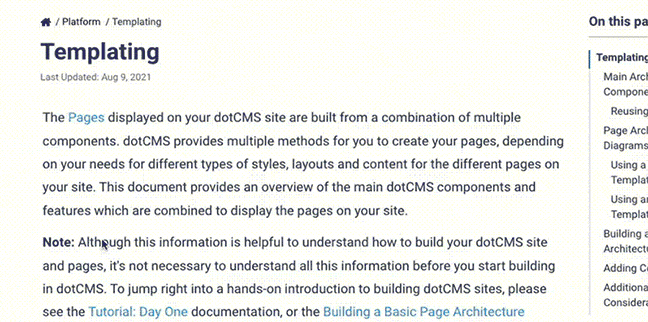dotCMS 2.1.1
Available: Aug 2, 2012
Overview of Changes
- The logging config now logs Velocity logging to its own file
- We made a few changes to the stater
- Solved a cluster issue which could prevent dotCMS from starting in 2.1
- Fixed a MSSQL permission caching issue https://github.com/dotCMS/dotCMS/issues/844
dotCMS 2.0.1
Available: May 21, 2012
Overview of Changes
- Addresses 2 security concerns with being able to shell in dotCMS via XSLT and from Velocity
dotCMS 2.0
Available: May 2, 2012
Overview of Changes
New Customizable/Extendable Workflow Engine (Enterprise)
- Allows the creation of multiple, muli-level workflow schemes for content and files.
- Workflows can trigger customizable chain of sub-actions, called Actionlets. Examples of what can be done with Actionlets include posting a value of a content field to a twitter account on publish or adding or removing a document/piece of content to a SOLR index on publish/unpublish, etc...
- Different content type can have different workflows.
Files as Content (Community & Enterprise)
- New file types can be created, fields can be customized on a per filetype basis.
- URL addressable binary files with all the benefits of being content.
- CDN friendly pathing to image manipulation with no query strings.
- Greatly improved Multi-file uploads
- Workflows can be applied to files based on their content types. So your photo library can have one type of workflow vs. your document library.
Full-Text and Metadata Extraction/Indexing (Enterprise)
- Metadata/content is extracted from files and is indexed and made searchable, including full-text indexing. This allows for document management solutions to be created using the dotCMS platform.
ElasticSearch for performance and horizontal scalability (Community & Enterprise)
- Index Replication/Auto-sharding
- Index once, available everywhere in clustered installations.
- Allows index infrastructure to scale separately from dotCMS installation based on an implementation’s need.
- Index shipping - Indicies can be backed up and restored across instances
Admin Tooling Improvements (Community & Enterprise)
- The CMS Maintenance UI now has an Index Manager
- Restful Access to manage dotCMS Indicies
Pessimistic Content Check-in / Checkout (Community & Enterprise)
- Content can be locked for editing - only the editing user or CMS Administrators can release the lock.
Content Editing UI improvements (Community & Enterprise)
- Workflows and content locking are integrated into an improved content editing UI.
Key/Value Field Type (Community & Enterprise)
- Allows a content type an unlimited number of values that can be determined when the content is being entered – think the specifications page for various electronic products in an ecommerce environment.
Data Model/API Improvements (Community & Enterprise)
- Content state has been moved to a separate table
- Identifiers, live and working versions all enforced by referential integrity
Plugin Improvements (Community & Enterprise)
- There is now a ROOT folder that can be added to plugins which can override ANY file in dotCMS. We recommend using this folder in the com.dotcms.config plugin (./plugins/com.dotcms.config/ROOT) to maintain any local changes to your /bin/startup scripts and tomcat's .xml configuration files.
OSGI Implemented(BETA) (Community & Enterprise)
- You can now HOT deploy Viewtools, Actionlets(Custom Workflow Actions) and other OSGI packages via OSGI without restarting your dotCMS installation.
- Initial beta of OSGI UI Portlet and Tooling
Spring 3 MVC Support (Community & Enterprise)
- dotCMS 2.0 ships with a Spring 3 View and View Resolver. This means that developers looking to implement controller logic in their CMS or content driven apps can use Spring MVC to implement their functionality in dotCMS. For more information, see this blog post.
Autoupdater (Community & Enterprise)
- The Auto Updater is improved and provides an easier folder structure to support updating
- Post 2.0 you will be able to download updates directly and use the Auto Updater to patch
Velocity Logging Improvements (Community & Enterprise)
- You can now see a stacktrace of templates for velocity errors
Things to Know
- 2.0 is a MANUAL upgrade from the 1.9 series; the 1.9 Auto Updater cannot be used to perform the upgrade.
- The Nutch based site search functionality has been removed because of library conflicts with the new Elastic Search libraries. For our Enterprise customers, there will be a much improved site search in the next release (already working in the lastest code in GitHub). For smaller sites and community members, we recommend using a hosted search provider such as Google Site Search, or setting up a standalone modern Nutch/Solr implementation and integrating with that.
- Lucene based content pulls and ordering
The new elastic search lucene implementation is much less forgiving about the "order by" clause in content pulls. If you do not see results for content pulls in your velocity code, make sure your order by clause has the structure name . the field name, e.g. "news.publishDate desc" rather than just "publishDate". When in doubt, try using the "moddate" to test that your lucene pulls are working. - Category Groups have been removed
We no longer support the long-depricated idea of "Category Groups". Categories are obviously still supported. - The ZIP distibution of dotCMS is now packaged differently to work with the new Auto Updater. You now have a ./dotserver directory which is the dotCMS itself and a ./autoupdater directory.
In addition to these directories, ./backups from the Auto Updater will be stored at the same level as the ./dotserver directory. You can clean these backups as you need/desire to. - There is no need to touch any file under the ./dotserver directory to config dotCMS. Use the new plugin /ROOT directory for your startup and tomcat config files and you can maintain them separate from dotCMS across version updates.
For information on how to upgrade to dotCMS 2.0 please review our documentation: Upgrading to dotCMS 2.0


